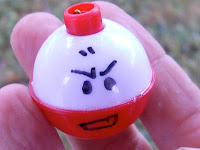I’m positive that you will enhance your fishing experience once you’ve gotten the hang of fishing with curly tail grubs. When you fish with live bait, the bait does the fishing, but when you fish artificials, you do the do the fishing by making the lure resemble something they want to eat; you have to know how the fish think. The next fishing lure every angler needs in their tackle box uses the slogan, “Think Like A Fish,” it’s the Storm Wildeye Swimbait. They are soft plastic bodies molded around an internal weight. There are some pros and cons to these lures, let’s just get the cons out of the way and then we will be free to discuss how truly awesome these things are.
 |
| My current Wildeye collection. Note the sunfish on the right with the missing tail. |
Most Wildeye Swimbaits have a single dorsal (back) hook and a ventral (belly) treble hook. The treble hook tends to get snagged a lot. When fishing in areas with a lot of snags, you can take the treble hook off; it’s only attached with a split ring. The lure isn’t quite as effective without the treble hook, but it’s better to lose fish than to lose lures. Also, a big fish tends to wreck these lures in a fight. The soft portion may be torn from the solid center, the tail may be bitten off, or the lead weight may be knocked loose from the dorsal hook. Honestly, any fish you can catch that’s big enough to wreck a lure is something to be proud of. Release the fish, and keep the lure as a trophy. And the final issue has to do with quality control. Sometimes you will get a lure that won’t swim straight, or the tail won’t move during the retrieval. I’m not sure if it’s the packaging or the production.
 |
| Ventral hook removed. |
Despite these setbacks, Wildeyes are amazing lures! They are usually sold in packs of three, and usually cost around $5.00. They are shaped and painted in many different body styles to resemble a wide variety of small fish that big fish eat, so these things attract just about any kind of fish that may occasionally eat smaller fish, and they are pretty easy to use, just cast out and reel in. The tail paddles on the retrieve making it look like a swimming bait fish, hence the name swimbait. You don’t have to work too hard to impart action into the lure, since the tail does it for you. The final reason you should have Wildeye Swimbaits in your tackle box is because of the size of the fish they catch. I am consistently shocked by the monsterous fish caught on these! The smallest fish caught with these was a 10” musky while bass fishing; to this day, it was the only musky i’ve ever caught. Here’s my list of fish caught on Wildeye Swimbaits.
- carp
- chinook salmon
- freshwater drum (sheephead)
- largemouth bass
- muskellunge
- northern pike
- rock bass
- smallmouth bass
- splake (brook trout X lake trout hybrid)
 |
| Suspending Wildeye Swim Shad. |
In the Great Lakes region, when the salmon are running up the streams in late summer, I like to cast a weighted walleye Wildeye (walleye Wildeye, walleye Wildeye, walleye Wildeye) into deep holes just before dusk. The eyes of the walleye pattern glow in the dark, and this drives the salmon crazy, and they will strike out of anger! A lot of times there will be deep holes under overpasses that hold big chinook. If you’re ever driving over a bridge in the fall and notice cars parked all along it, chances are pretty good that the salmon are running.
 |
| West Michigan's White River under the countyline bridge. |
 |
| White River from the bridge. |
 |
| This beautiful chinook took a Wildeye walleye. |
 |
| My cute little wife talks to seagulls along the inner Muskegon Channel pier. |
In Great Lakes marinas, like Milwaukee’s McKinley Marina there are usually some nice fish, like bass, brown trout, carp, pike, walleye, and in the fall, salmon, but lots of snags. If you get hung up, make a mental note of it. You don’t want to lose your lure on a picnic table that someone used for ice fishing that didn’t get removed before the thaw, but it probably provides cover for a really nice bass, be careful! Fish love the shade provided by docks, and the shoreline has some nice rocks for cover. “Think Like A Fish” and have fun, I bet you can figure it out!
 |
| even carp will strike these! notice the sunfish Wildeye in his mouth. |
There is one more lure that everyone needs in their tackle box that I will talk about in my next post. It’s sort of a last resort, when you don’t know what the fish will strike, you’ll be glad to have this Jedi Master of a lure in your arsenal. Hope the suspense doesn’t kill you!



























